Deep Vein Thrombosis at right upper limb: A case report
Vijayalakshmi1, Shalini2
1Non Critical Ward Incharge, Kauvery Heartcity, Trichy, India
2Non Critical Ward Senior Staff Nurse, Kauvery Heartcity, Trichy, India
Correspondence: M: +91 8508698000: email: nursing.heartcity@kauveryhospital.com
Abstract
Deep venous thrombosis (DVT) is a manifestation of venous thromboembolism (VTE). Although most DVT is occult and resolves spontaneously without complication, death from DVT-associated massive pulmonary embolism (PE) causes as many as 300,000 deaths. The incidence of DVT in India in the general population is about 1.79 per thousand. Approximately 30% of patients with symptomatic VTE manifest with PE, and others with DVT. More than 50% of post- surgical procedures patients are at risk of developing VTE.
Case Presentation
A 35-year-old male, had complaints of right upper limb swelling since 3 days for which he was initially treated at an outside hospital and came here for further management.
Past History
Patient is a known case of CAD, S/P CAG – Single vessel disease with thrombus (22/02/2020). There is no history Diabetes mellitus & Hypertension.
On Examination
Patient was conscious, oriented and vitals were stable.
- Right Upper extremity swelling
- Edema,
- Tiredness,
- Numbness.
Clinical Signs
- Mild bluish and black discolorations
- Swelling of Right Upper Limb
- Warm skin
Investigations
ECG revealed no acute changes and echo revealed fair LV function. Patient was taken up for Doppler where his right upper limb arterial Doppler study was normal whereas right upper limb venous Doppler showed right upper limb DVT.
ECG Report
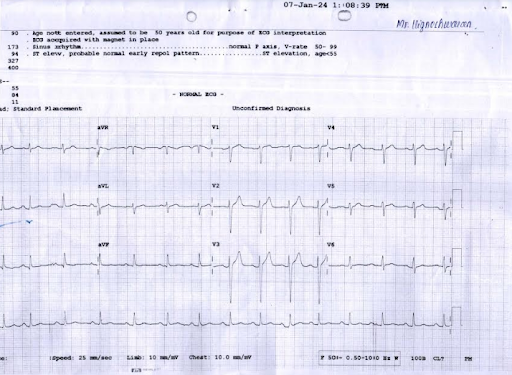
ECHO Report
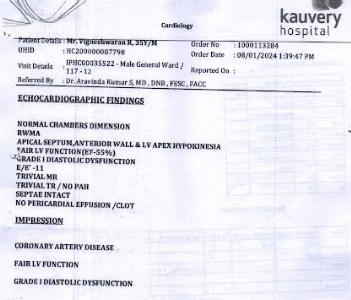
Doppler Report
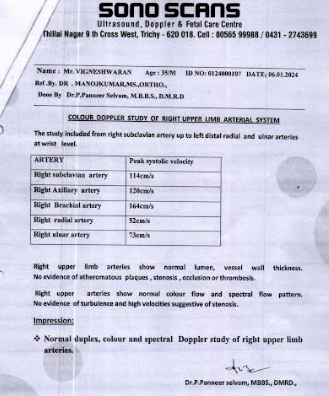

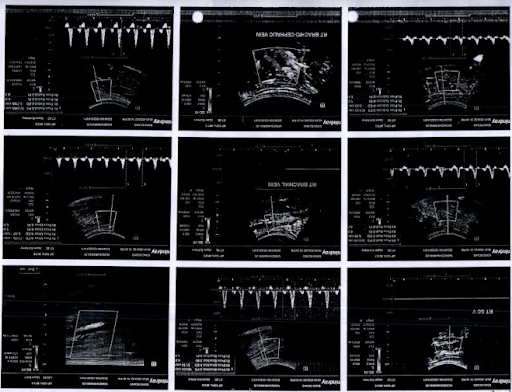
DVT Image
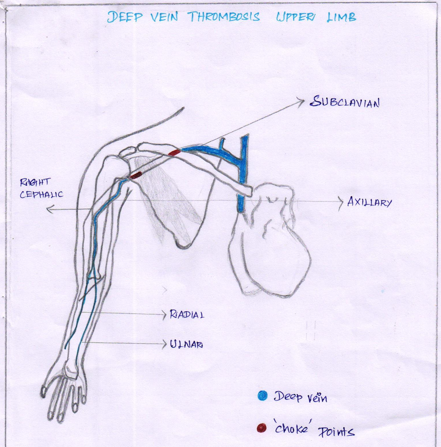
Diagnosis
Right upper limb deep vein thrombosis
Comorbidities
- CAD
- Old AWMI (lysed with Inj. Streptokinase)
- S/P CAG – Single vessel disease with thrombosis
Treatment provided
- Patient was started with IV anticoagulants.
- Medical stabilization done.
- Patient was treated with IV anticoagulants, anti-platelets, statins, beta-blockers, PPI and other supportive measures.
- Patient condition improved and discharged in a stable state.
Medications
- Inj. Clexane 0.6mg – 1-0-1
- Tab. Rozalet 75/10mg – 0-0-1
- Tab. Cardivas 6.25mg – 1-0-1
Discussion
- Deep Vein Thrombosis (DVT) occurs when there is a clot in a vein that is deep within your body. If this happens in your upper extremity (Arm, wrist, or hand). It is called Upper – Extremity DVT caused trauma an incidence about 1 per 1000 persons per year.
- Causes;
- Trauma, infection, inflammation
- Heart failure, malignancy, Thrombophlebitis
- Family history of blood clots
- Bed rest or sitting too long without moving such as during travel.
- Venous catheterization.
- Symptoms;
- Upper extremity swelling
- Pain or tingling
- Heaviness, bluish discoloration
- Feelings of Pins and needles
- Palpable tender cord, arm and hand edema
- Jugular venous distension.
- Diagnosis;
- Venous ultrasound (US) first line imaging method.
- D – Dimer
- Duplex ultrasonography
- Venography
- Contrast – enhanced computerized tomography (CT)
- Magnetic resonance imaging (MRI).
- Management;
- Blood thinning medication (Anti coagulation) such as heparin and warfarin
- Oral anticoagulation generally continued as maintenance treatment for 3-6 months
- Support stockings (compression stockings).
Nursing Management
The common nursing measures to be taken are:
- Monitor the vital signs and record.
- Assess the site of deep vein thrombosis if any colour changes
- Administer oral and IV anticoagulant medication given
- Managing pain
- To promoting circulation through compression therapy and activity
- To apply warm application
- To graduated compression stockings, warm application
- Educating the patient about DVT and self-care measures.
- Providing psychological support
- Promotion of circulation and prevention of complication
- Preventing pulmonary embolisms
- Observe the generalized duskiness and cyanosis in the earlobes, lips, tongue and buccal membrane.
- Encourage rest periods and limit activities.
- Assist with frequent changes of position.
Conclusion
Patient’s condition gradually improved and he was discharged with the following advice
- To restrict vitamin K diet
- To take medications as per following doctor’s advice regularly
- Tab. Eliquis 5mg – 1-0-1
- Tab. Rozalet 75/10mg – 0-0-1
- Tab. Cardivas 6.25mg – 1-0-1
- To have regular follow-up
- To watch for breathing difficulty or any bleeding, if noted, to visit doctors
- To regularly apply DVT stocking
- To walk every day and gradually adding more time to each walk
- Advised not to stand or sit in one place for a long time
- Advised to avoid smoking
- Advised to avoid sports activities when taking blood thinners, due to risk of bleeding from trauma.

Ms. Vijayalakshmi
Non Clinical Ward Incharge

Ms. Shalini
Senior Staff Nurse
